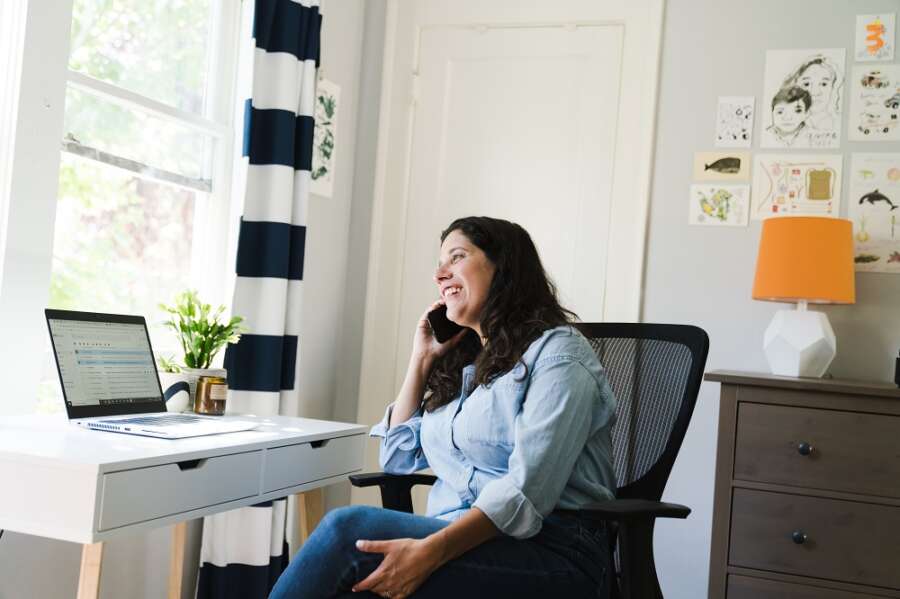
By Al Fox, Director, Fox Agency
Taking care of the mental health and wellbeing of our employees at Fox Agency has always been high on our agenda, long before Covid-19 hit and working from home became the norm.
We now operate a hybrid working model, which we believe is the best option for the business and the team, and as part of this we have further ramped up our focus on health and wellbeing.
We run weekly online personal training sessions, as well as yoga, meditation and mindfulness programmes. The whole team has access to health plans, a 24-hour helpline for any of life’s issues and we also have a trained Mental Health First Aider in house. We’re also keeping ‘agency life’ alive with weekly social calls for quizzes, guest tutorials, catch-ups and even a virtual stand-up comedy gig in aid of Comic Relief.

Al Fox, Director, Fox Agency
There’s no doubt that working from home can help with concentration and free us from distractions when we really need to focus on the task in hand. It also helps our personal lives, enabling us to get more rest and be more flexible and adaptive to family life.
However, although working from home has brought many benefits, it has also presented some unique challenges. Some people’s home working situation might not be as peaceful as others, working alone can lead to feelings of isolation and loneliness, and for a business it can hinder collaboration and group thinking, to name but a few.
So how do ensure everyone is okay?
Communication is key
It’s absolutely vital to get feedback from team members to understand how they are feeling and what is, or isn’t, working for them if they are working from home. The pandemic has created all sorts of uncertainty, so asking people what they think and finding out how it’s going for them can provide valuable insight for any organisation. We conducted an employee survey, and the feedback has helped us create our own hybrid working policy.
As we begin to return to some semblance of normality, adopting a hybrid approach to working might be the way forward for your business. However, it’s important that this is given plenty of consideration to ensure the policy is fair and works for everyone.
Our survey found that many team members appreciated the increased flexibility and independence that working from home provided. Spending less time commuting was seen as another big advantage which aided their focus and gave them more time to relax outside of work. Conversely, some mentioned that not having the commute meant they no longer had a distinction between work and home, so lines became blurred.
Almost everyone said they missed being around and working with their colleagues as well as having that change of scenery. Others, while glad they had their own well-equipped, separate home-working spaces, couldn’t help putting themselves in the shoes of those less fortunate.
A flexible approach
A recent report from Accenture found that 83% of 9,326 workers surveyed say they prefer a hybrid model, in which they can work remotely at least 25% of the time.
We are all on a journey and learning how to adapt to the new normal. This requires some trial and error of course, as with any big change. Processes have been tested, working patterns honed, and schedules challenged. Throughout this it’s become crystal clear that hybrid working does not suit rigid processes and patterns.
Let staff who want to work full time in the office do so – parents with young children, or colleagues without slick internet or private office spaces are unlikely to be champing at the bit to work from home three days a week. Equally, there are those happier at home and if they can do their jobs fully remotely, then that should be accepted.
Promote a positive culture
Hybrid working must be about establishing compromises that incorporate the flexibility and independence of working from home with the social, organisational, and cultural benefits of working from the office. It’s all about tweaking your model but that said, it’s never going to be perfect.
If your team is separate most of the time, or only interacting with a select number of their colleagues, in-groups and out-groups will form, which can harm cohesion and create a them versus us mentality.
Make sure silos are few and only used when absolutely necessary, that there are plenty of spaces for group communication, and all employees are kept abreast of changes occurring within teams and the wider company.
Establish boundaries
According to The Royal Society for Public Health (RSPH) in its Disparity Begins at Home Report, over half (56%) of the respondents said that working from home made it harder to ‘switch off’ at the end of the day. It’s more important than ever to take time to relax now that the lines between our work lives and our personal lives are blurred.
It can be tricky to separate the two, for instance if someone is working from their kitchen table, they can’t just close the door and forget about work until the next day, so it’s important to have some sort of routine to separate work time from leisure time. This could be going for a walk, seeing a friend or preparing dinner; just something to signify that the working day has ended.
Working outside of normal hours should also be discouraged. Although we operate in a fast-paced creative industry, so there will always be deadlines that need meeting, we discourage our team from sending emails out of hours unless there is a specific and urgent reason to do so. If it can wait, let it wait until working hours.
Throughout the day it’s important to take breaks but sometimes we forget to do so. Not taking enough breaks can impact mood, creativity and motivation, so make sure you’re giving yourself enough breaks. You’ll feel a lot better when you return to the computer screen.
Get yourself connected
Encouraging social interaction is more important than ever. We have a Fox Agency Social Committee which regularly puts on virtual events for the whole agency and brings everyone together to let off steam and have some fun. We have a social channel on Teams as well as a Film, TV and Book Club, which enables people to take a moment to talk about something other than work.
We also have a weekly Friday Social when we all log off early and meet up virtually for themed activities from pub quizzes to Pictionary. This is a great way to unwind and see colleagues you may not have had any interaction with that week. It’s also a great way to get to know the new faces that have joined the agency during the pandemic.
Research from RSPH in its Disparity Begins at Home Report found that as a result of working from home, over two thirds (67%) of respondents said they felt less connected with their colleagues.
Regularly checking in on teammates and keeping virtual chats and check-ins going also helps those working at home not feel excluded.
Promote the use of mental health support services
Employees should be encouraged to use their mental health and wellbeing officers and support services if these are available. It’s a good idea to have a Mental Health First Aider in your team so if anyone is struggling, for whatever reason, they have someone to talk to confidentially.
Employee Assistance Programmes are also great and can offer support on a range of work-related and personal issues. These schemes are run externally, so employees can feel reassured that no matter what they discuss, no one at work will ever know.
Energise and relax
Working from home can often mean that we don’t get enough exercise. Many of our team members take part in our weekly PT sessions held in work time, and the benefits are huge, with many leading more active and healthy lifestyles outside of work too. At present, we also have a charity event where all the cyclists in the agency are aiming to complete a collective distance equivalent to the length of the British Isles – unfortunately, we still have a long way to go on that!
Our focus on wellbeing is such that carving out time to join in, let off some steam, and bond with the team is very much encouraged. All our virtual activities have had a huge impact as well as making new hires feel welcome and avoiding any segregation between the office originals and the remote newbies.
There’s no comprehensive list of what works and what doesn’t, as what’s great for some, is awful for others. For example, some can’t think of anything worse than a PT run bootcamp, but loved the photography tutorials we held with a professional press photographer recently. Mix it up because a commitment to trying lots of different things is essential.
We all spend a lot of our lives at work, so why not make it a happy place to be? A happy and content team manifests itself in better work, happier clients and a thriving organisation.


